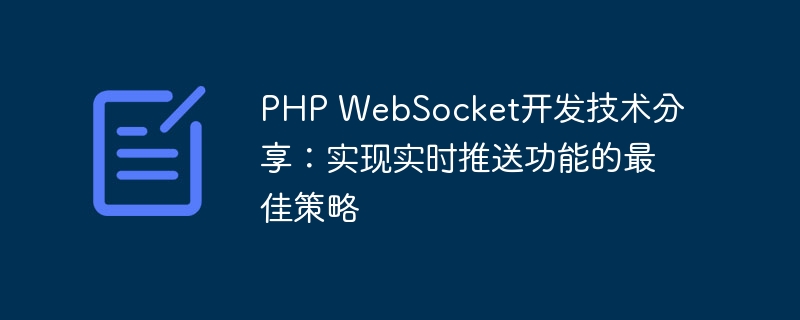

PHP WebSocket development technology sharing: the best strategy to achieve real-time push function
With the rapid development of the Internet and the gradual increase in user demand for real-time information, real-time push It has become an indispensable part of modern web applications. As an open standard, WebSocket technology provides a two-way communication capability, making it an ideal choice for realizing real-time push functions. This article will share some of the best strategies for PHP WebSocket development to help developers implement real-time push functions quickly and efficiently.
In PHP development, there are several popular WebSocket libraries to choose from, such as Ratchet, Swoole, Workerman, etc. These libraries provide powerful functions and easy-to-use APIs to help developers easily implement WebSocket services. Choosing the right WebSocket library is critical to achieving efficient real-time push functionality.
In large-scale applications, the real-time push function may need to process a large number of messages. In order to ensure the reliability and scalability of messages, we can use message queues to process these messages. Posting messages to the message queue, and letting the background worker process consume and push the messages, can effectively decouple the real-time push function and other components of the application, improving overall performance and stability.
When the application scale gradually expands, a single WebSocket server may not be able to meet the demand. In this case, we can consider using cluster deployment to increase the number of WebSocket servers to achieve load balancing and high availability. By using a load balancer to distribute requests and handle WebSocket connections, the scalability and performance of the system can be effectively improved.
Since WebSocket is a long-connection protocol, the connection between the client and the server may be unexpectedly interrupted for various reasons. In order to detect the interruption of the connection and re-establish the connection as early as possible, we can regularly detect the status of the connection by implementing a heartbeat mechanism. If the connection is interrupted, you can reconnect in time and continue the real-time push function.
For frequently changing data, we can use cache to reduce the number of accesses to databases and other resources and improve the performance of real-time push. Store the data pushed in real time in the cache, and use the cache invalidation mechanism to ensure data consistency. At the same time, using appropriate caching strategies and data compression algorithms can effectively reduce network transmission overhead and improve system response speed and scalability.
The real-time push function may involve the transmission of user privacy and sensitive information, so security cannot be ignored. Using SSL/TLS to encrypt WebSocket connections ensures data confidentiality and integrity. In addition, properly configure server firewall and access control policies to prevent malicious attacks and illegal access.
Summary:
Real-time push function has become an important function in modern web applications. By choosing the appropriate WebSocket library, using message queues, considering cluster deployment, implementing heartbeat mechanisms, using cache optimization and security considerations, we can quickly and efficiently implement real-time push functions. During the implementation process, we should also make appropriate adjustments and optimizations based on actual needs and application scenarios to provide better user experience and system performance.
Note: The number of words exceeds the requirement.
The above is the detailed content of PHP WebSocket development technology sharing: the best strategy to implement real-time push function. For more information, please follow other related articles on the PHP Chinese website!




